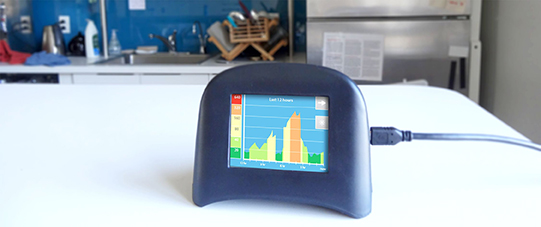Carnegie Mellon Spinoff Introduces Speck, a Personal, Wi-Fi-connected Air Quality Monitor Device Measures Fine Particulate Air Pollution Levels in Homes
Byron Spice Monday, March 16, 2015Print this page.

Speck, a personal air pollution monitor introduced today at the SXSW Interactive Festival in Austin, Texas, will enable people to monitor the level of fine particulate matter suspended in the air inside their homes, helping them assess if their health is at risk.
Developed at the Carnegie Mellon University Robotics Institute and now being marketed by a CMU spinoff company, Speck provides individuals with an unprecedented depth of knowledge about their personal exposure to particulates known as PM2.5 — the tiniest of particulates, capable of lodging deep in the lungs and aggravating heart and lung diseases.
"Sometimes you can see air pollution as a haze in the distance, but in and around your home, it's invisible," said Illah Nourbakhsh, professor of robotics. "You might know the PM2.5 level at a government monitoring station miles away, but without a sensor such as Speck, you can't know what is in the air you breathe and how it might change based on prevailing winds, time of day or what you're doing."
Knowledge of particulate levels empowers people to reduce exposure by opening or closing windows, altering activities, or taking action such as using HEPA air filters, Nourbakhsh said.
In the Pittsburgh region, about 300 Specks are already in use. Some are used in homes to monitor indoor air quality for people susceptible to asthma or other conditions, while others are being used by citizen groups to monitor particulates emitted by coke batteries or by natural gas production.
One family in a pilot project, for instance, had a young asthmatic daughter. Family members had installed an air conditioner to help her breathe, but didn't realize until they used Speck that particulate levels increased when the air conditioner was running, Nourbakhsh said. They subsequently purchased a filter for the air conditioner.
Speck has a display screen that shows instantly whether unhealthy levels of particulates are present. It also is Wi-Fi-connected, enabling the monitoring data to be uploaded to a database controlled by the user. The Speck data also can be integrated with vital signs and other personal data recorded by personal devices such as Fitbit and Jawbone.
"It's not just a sensor; it's a data system," Nourbakhsh said. "You own your own data." A Speck site stores the data and provides analytical tools, including links to readings from federal air monitoring stations. The user has free access to the site and can decide whether to share their monitoring data.
Speck was developed over the past four years in Nourbakhsh's CREATE Lab. He has established a spinoff company, Airviz Inc., to market the devices, which are on sale online, beginning today, for $200 each at https://www.specksensor.com/. The Speck is designed and assembled in Pittsburgh.
Low-cost particulate sensors are notoriously inaccurate, producing readings that sometimes don't even agree with each other. But Nourbakhsh's research group achieved high accuracy by employing machine learning algorithms — programs that learn to recognize and compensate for the spurious "noise" in the sensor signals — while maintaining affordability.
In the Pittsburgh area, even those who can't afford to buy their own Speck can take advantage of the technology. The Heinz Endowments and Pittsburgh Foundation have paid for 1,000 Specks, which will be made available to individuals through public libraries, schools and citizen groups in the Pittsburgh region. The Carnegie Library of Pittsburgh's Squirrel Hill branch is the first to have Specks, with 10 available for loan. Also, anyone can go to the specksensor.com and type in their zip code to retrieve the latest as well as historical air quality readings from the nearest federal air monitor.
The Southwest Pennsylvania Environmental Health Project, which investigates the health effects associated with natural gas drilling, has about 115 Specks it has been using for the past year to investigate health complaints of residents near drilling sites. The project installs the monitors at each residence for one to three months and then analyzes the data, said Ryan Grode, environmental health educator.
"Overall, we're really happy with them," Grode said. "It's really user friendly."
Byron Spice | 412-268-9068 | bspice@cs.cmu.edu
